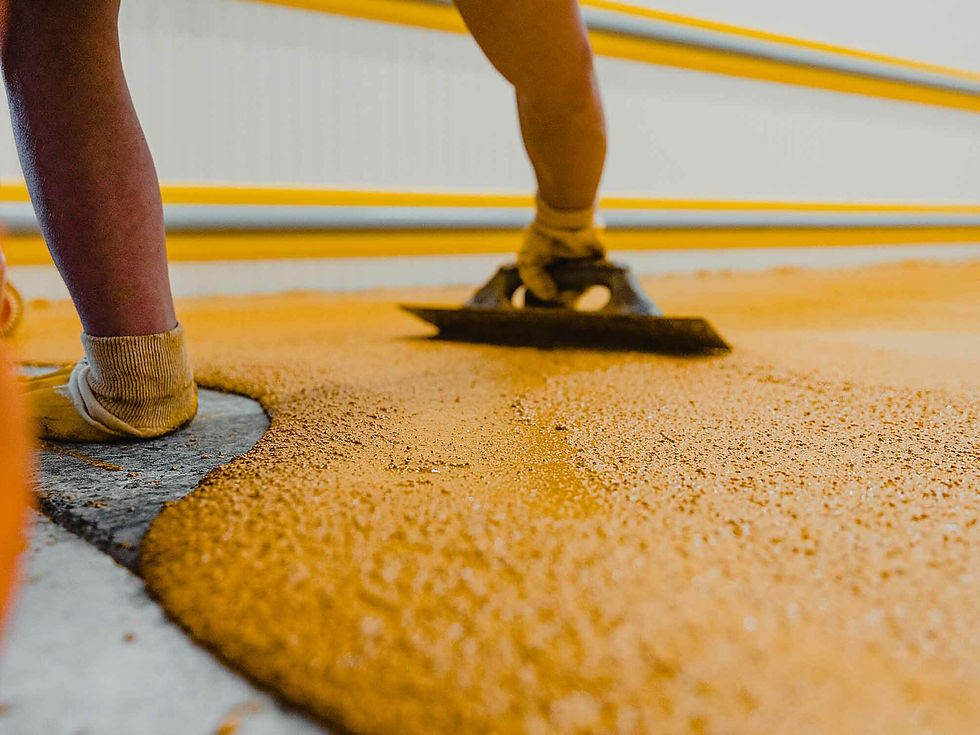Urethane Cements: Where & Why Contractors Use Them
- Amee Curtis

- Sep 12
- 2 min read

When a client needs a floor that can handle boiling water, forklift traffic, acids, and bacteria—all at once, you don’t reach for epoxy. You reach for urethane cement.
This hybrid powerhouse is one of the most durable, chemical-resistant, and temperature-tolerant flooring systemson the market. But it’s not for every job—and it installs differently than most coatings.
In this post, we’ll cover where to use urethane cement, why it outperforms in tough environments, and what you need to know to install it successfully.
What Is Urethane Cement?
Urethane cement (also called polyurethane concrete) is a 3-component system made of:
Part A: Isocyanate resin
Part B: Polyol or polyether
Part C: Cement-based powder
Together, they form a self-leveling or trowelable slurry that bonds to concrete and resists just about everything.
Think of it as epoxy’s bigger, tougher sibling—with built-in strength from Portland cement.
Where Urethane Cement Shines
It can handle steam cleaning, spills, and cold-to-hot transitions without cracking or peeling.
Key Advantages of Urethane Cement
✅ Thermal Shock Resistance
Can go from freezer to boiling wash-down without delaminating—something epoxy cannot do.
✅ Moisture Tolerance
Can be applied on green concrete or high-MVER slabs. No vapor barrier needed.
✅ Slip-Resistant Texture
Broadcast with quartz or aluminum oxide for OSHA-compliant traction.
✅ Zero VOCs
Safe for occupied buildings, food zones, and interior use.
When NOT to Use Urethane Cement
Decorative installs (flakes, metallics, or high-gloss finishes)
UV-exposed zones without a protective topcoat
Tight budget projects (material costs are higher than standard epoxy)
Thin-mil applications—urethane cement typically builds 1/8" to 3/8"
Installation Basics
Surface Prep:
Shot blast or diamond grind to ICRI CSP 3–5
Clean and degrease thoroughly
No primer needed for most systems
Mixing:
Mix all three components quickly and completely
Short working time—only mix what you can place
Application:
Pour, rake, or trowel evenly
Broadcast if traction or topcoat is required
Use spike shoes to maintain even surface
Pro Tip: Work in teams of 2–3 to keep material moving. Once it kicks, it kicks fast.
Trusted Products at PNW ECS
Duravel Urethane Cement
Kretus Urethane Cement SL & TG
Citadel Polyurea Urethane Systems (for hybrid setups)
Ask us about:
Quartz and aluminum oxide broadcast media
Moisture test kits
Topcoats for UV or aesthetic protection
Conclusion
Urethane cement isn’t the flashiest floor system—but it’s one of the toughest, most trusted choices for demanding commercial and industrial spaces.If your client needs cleanability, durability, and total resistance to chaos, this is your go-to system.
At PNW ECS, we’ll help you choose the right system, tools, and media for the job—and teach your crew how to install it the right way.
📍 Fife & Sandy LocationsNeed a urethane cement quote or walkthrough? Stop in with your project specs and we’ll help you build the right floor, step by step.




Comments